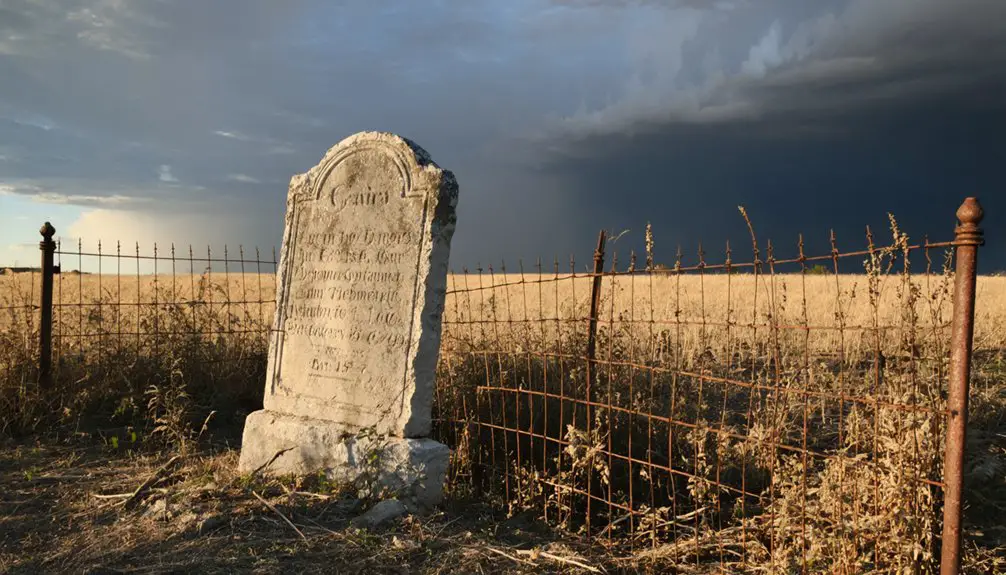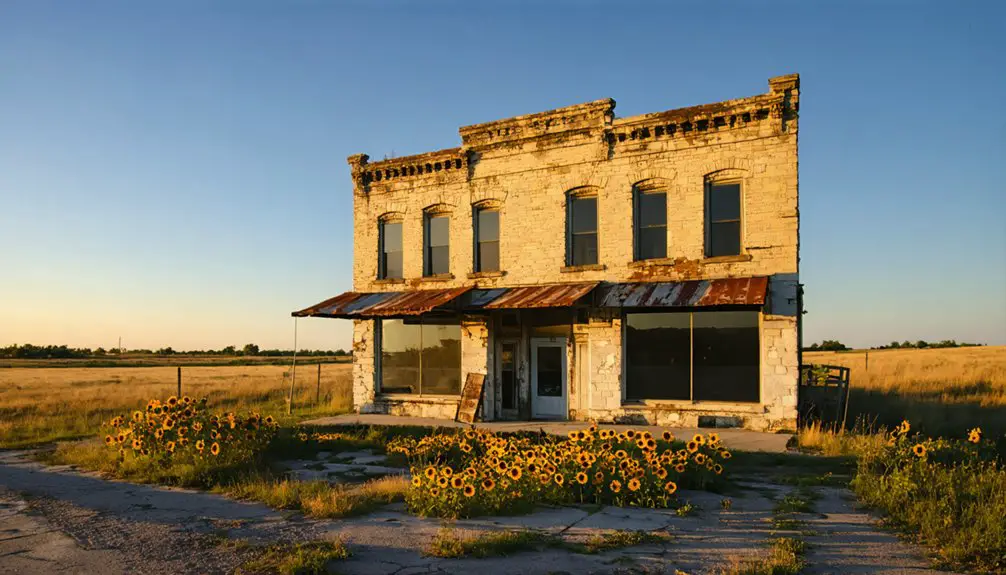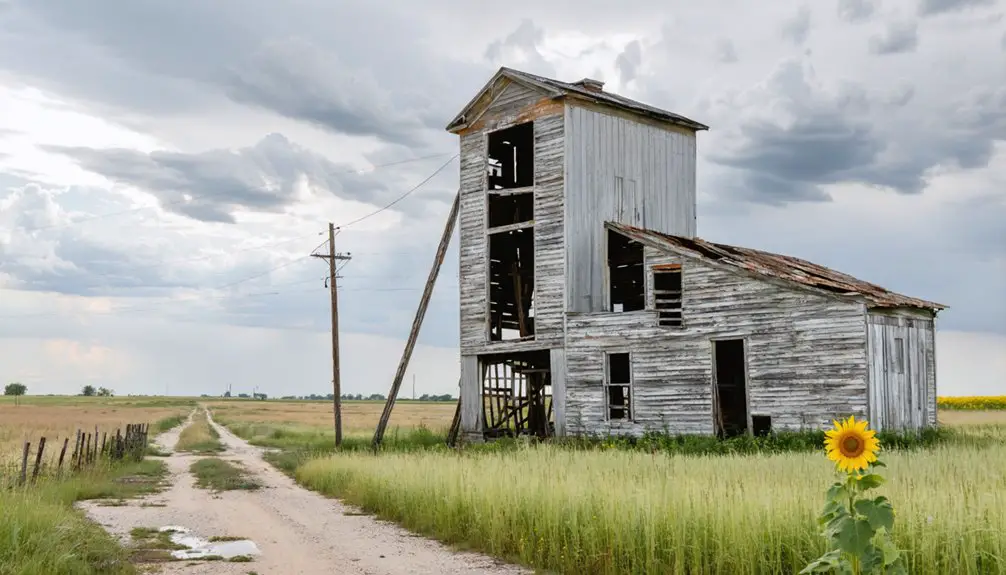You’ll discover Cain City as one of Kansas’s most intriguing ghost towns, established in 1877 by Canadian entrepreneurs seeking to create a German Baptist colony. Within months, the settlement grew to 3,000 residents and thrived around farming and religious life. When the Missouri Pacific Railroad bypassed the town, residents attempted two relocations before abandoning their dreams. Today, only the cemetery remains, marking a fascinating chapter of pioneer ambition and railroad-era settlement patterns.
Key Takeaways
- Founded as a German Baptist colony in Ellsworth County, Kansas, Cain City reached 3,000 residents by summer 1877.
- The Missouri Pacific Railroad’s decision to bypass the town led to its rapid economic decline and eventual abandonment.
- Two relocation attempts failed, including one to follow the railroad’s right-of-way and another due to flooding.
- Only the Cain City Cemetery remains as a physical landmark, established by the German Baptist colonists in 1877.
- The town’s demise exemplifies how railroad access determined the survival of frontier settlements in late 1800s Kansas.
A Canadian Dream in Kansas
While many frontier towns sprang up across Kansas in the late 1800s, Cain City emerged as a unique Canadian venture in southwestern Ellsworth County.
Like nearby Holyrood’s Canadian settlers, the town’s early residents sought to build a new life in Kansas. Similar to the initial Town of Kansas incorporation in 1850, these settlers were determined to establish formal roots. You’ll find its origins traced to Professor E. C. Janzen and Henry Strassen from Illinois, who envisioned establishing a German Baptist colony that would preserve their Canadian heritage. They struck a promising deal with Kansas Pacific Railroad, securing about 11,500 acres for their settlement.
The immigrant aspirations took shape as the founders successfully met their deadline to sell 10 sections of land by March 31, 1877. Their achievement earned them an 80-acre donation from the railroad for church purposes, laying the foundation for a community that would embrace both religious devotion and cultural traditions.
Railroad’s Decisive Impact
The Missouri Pacific Railroad‘s decision to bypass Cain City marked the beginning of the settlement’s decline.
You’ll find that railroad influence played a decisive role in determining which Kansas towns flourished and which became ghost towns during this era. When the railroad chose Rice County instead, Cain City’s residents desperately tried to salvage their future by relocating closer to the rail right-of-way. Local businessmen, like those who founded the Kansas Central Railway, had witnessed how towns without rail connections were often bypassed by economic progress.
Despite their efforts, the settlement patterns had already shifted against them. The Kansas Pacific Railway‘s completion in 1870 established major growth corridors, while towns without rail access struggled to maintain viability. Kansas once boasted third highest rail mileage in the nation due to its strong agricultural base.
Competition between rail companies and financial challenges further complicated development plans.
Today, all that remains of Cain City’s original location is a cemetery – a stark reminder of how railroad decisions shaped the destiny of frontier settlements.
Life in Early Cain City
Life in early Cain City centered around farming activities and religious services, with Canadian settlers and nearby German Baptist colonists forming distinct but cooperative communities.
You’d find the pioneers attending church services in their stone church while anxiously awaiting news about the Missouri Pacific Railroad‘s planned route through their settlement.
When the railroad chose to build its line through Rice County instead, you’d witness the gradual exodus of settlers as their dreams of a prosperous railroad town slipped away. Much like the fate of the Underground Railroad route through Quindaro, Cain City’s important transportation links ultimately failed to sustain the settlement. The town’s rapid population growth, which reached 3,000 by summer 1877, showed how quickly frontier settlements could boom before their eventual decline.
Daily Pioneer Activities
Daily routines in Cain City centered around three primary activities: farming the 11,500-acre colony land, attending religious services at the stone church, and conducting business along the railroad lines.
As a pioneer in this German Baptist settlement, you’d spend your days working the fertile Kansas soil, joining your neighbors for community gatherings at the church built in 1879. Your life would revolve around the changing seasons of pioneer agriculture, while staying mindful of passing trains that brought both opportunity and challenge to your doorstep.
You’d need to navigate the social dynamics of permanent residents and transient railroad workers, whose tent cities dotted the landscape. While these temporary settlements brought economic opportunities, they’d also introduce elements of disorder that you’d have to carefully manage in your daily affairs. Much like the settlers of Old Shawnee Mission, the community maintained strong religious and educational foundations. Like many other Kansas boomtowns, the community’s fortunes were closely tied to the railroad’s presence and eventual decisions about route changes.
Railroad Dreams Fade Away
Despite ambitious efforts to attract the Missouri Pacific Railroad, Cain City’s hopes for becoming a thriving rail hub began crumbling when the company chose a route through neighboring Rice County instead.
You’d have witnessed the town’s desperate attempt to salvage its future by trying to relocate closer to the railroad’s right-of-way in Rice County, but even this bold move couldn’t secure its survival.
During this era of rapid railroad expansion across Kansas, having a rail connection meant the difference between prosperity and abandonment. Public land grants by the federal government were crucial for stimulating railroad construction, with companies receiving up to 6,400 acres per mile of track laid.
While other Kansas communities benefited from federal land grants and government aid to attract railways, Cain City’s economic decline proved swift and irreversible.
Today, only a cemetery remains at the original site – a silent reminder of a frontier town’s failed railroad dreams.
Much like the later development of the Kansas Speedway in Kansas City, transportation infrastructure would prove vital to the economic success of Kansas towns.
The Failed Relocation
After the devastating 1867 flood, you’ll find that Cain City’s residents first moved their town two miles northwest to higher ground near the planned Missouri Pacific Railroad tracks.
You’ll discover that when the railroad ultimately built its line in Rice County instead of Ellsworth County, the townspeople attempted a second relocation to follow the railroad’s right-of-way.
Despite their determined efforts to establish themselves along the new rail line in Rice County, Cain City’s second relocation proved unsuccessful, and the town eventually faded into history with only its original cemetery remaining in Ellsworth County.
Moving Town Site
When floodwaters engulfed Cain City’s main street with four feet of standing water in June 1867, residents made the pivotal decision to relocate rather than rebuild.
They chose a site approximately two miles northwest on higher ground, away from the flood-prone Smoky Hill River. The town relocation coincided perfectly with the Missouri Pacific Railroad‘s plans to lay tracks through Rice County.
You’ll find it interesting that the move happened quickly – by early July, they’d already laid out new lots.
The post office’s establishment on July 17 marked the official recognition of the new location.
Despite the environmental challenges of high river levels complicating transport and mail services, the community pushed forward with their ambitious move.
They used boats to ferry passengers and mail across the still-swollen Smoky Hill.
Railroad Dreams Dashed
While Cain City‘s citizens worked tirelessly to secure a railroad connection through their town, the Missouri Pacific Railroad‘s decision to route through Rice County instead of Ellsworth County proved fatal to their ambitions.
The Kansas Central Railway‘s financial troubles in 1873 had already dealt the first blow, halting construction and reducing service. Despite strong community support and efforts to secure railroad financing through stock transfers and local funding, the situation worsened when Kansas Central entered receivership in 1877.
You’ll find that even though some townships voted aid to resume construction that same year, it wasn’t enough. When Missouri Pacific bypassed Cain City entirely, the town’s desperate attempt to relocate closer to the new rail line in Rice County couldn’t save it from becoming a ghost town.
Legacy in Stone: The Cemetery

Today, the Cain City Cemetery stands as the sole surviving landmark of a once-thriving Kansas settlement, marking the original site in southwestern Ellsworth County where German Baptist colonists first established their community in 1877.
Amid Kansas prairie winds, Cain City Cemetery endures as the last witness to German Baptist pioneers who settled here in 1877.
You’ll find the cemetery’s cultural heritage etched in stone through its earliest burials, including Mary Gibson (1880) and Josephine Godfrey (1901). The weathered tombstones tell stories of founding families, preserving essential genealogical information about the area’s pioneers.
The site’s significance extends beyond mere burial records – it’s a physical representation of the religious foundations laid by E.C. Janzen and Henry Strassen, who led the first German Baptist colony here.
Though the town relocated along the Missouri Pacific Railroad line and eventually vanished, the cemetery remains, silently documenting the spiritual and cultural legacy of Kansas’s early settlers.
Neighboring Ghost Towns
Throughout the late 1800s, numerous ghost towns emerged near Cain City, creating a network of abandoned settlements that paint a broader picture of Kansas’s pioneer history.
You’ll find Lexington ruins scattered across Clark County, while Cash City met its end in 1895. The Letitia history unfolds southwest of Minneola, where time has erased most traces of its existence.
Castle Rock’s geological formations in nearby Trego County stand as silent witnesses to another lost community.
In surrounding regions, Elk significance lives on through its few remaining structures, while Floral memories in Cowley County reflect the era’s rural exodus.
The Bittercreek legacy, spanning 1879 to 1899, tells of brief prosperity, and Riverdale future remains uncertain as its population dwindles, echoing the fate of many Kansas frontier towns.
Preserving Pioneer Stories

These abandoned settlements hold rich stories that live on through dedicated preservation efforts. You’ll find Cain City’s pioneer tales preserved through county histories, settler diaries, and newspapers, while oral histories from descendants keep personal accounts alive.
The cemetery stands as the main physical reminder, with local historical societies protecting remaining artifacts and structures from decay.
You can explore these pioneer stories through educational programs, interpretive markers, and heritage festivals that bring history to life. Digital archives now make historical records accessible online, using GIS technology to map settlement locations.
While preservation faces challenges like limited physical remains and natural deterioration, community volunteers actively support cleanup projects and storytelling initiatives to guarantee these important pioneer narratives endure for future generations.
Frequently Asked Questions
What Native Tribes Originally Inhabited the Land Where Cain City Was Built?
You’ll find the Kansa (Kaw) and Osage tribes were the primary Native tribes with cultural heritage in eastern Kansas where Cain City stood, though Pawnee and Comanche also traversed the region.
How Many Residents Lived in Cain City During Its Peak Population?
You’ll find that 75 residents marked the peak population dynamics in 1925, showcasing the town’s limited historical significance before declining sharply after the railroad’s closure in 1944.
Were There Any Notable Crimes or Lawlessness Incidents in Cain City?
You won’t find records of specific crime history in this settlement. While nearby railroad tent cities struggled with law enforcement issues, there’s no documented evidence of notable lawlessness here.
What Businesses and Services Existed in Cain City Before Its Decline?
Like a pioneer’s dream turned reality, you’d find general stores, bakeries, drugstores, and livestock trading businesses. Community services included railroad depots, churches, and agricultural supply shops serving farmers and settlers.
Did Any Famous Historical Figures Ever Visit or Stay in Cain City?
You won’t find any records of famous visitors or historical events involving notable figures in Cain City. The town’s brief existence was marked by railroad decisions rather than celebrity appearances.
References
- https://womiowensboro.com/this-kansas-city-area-ghost-town-was-part-of-underground-railroad/
- https://fhsuguides.fhsu.edu/kansasheritage/ellsworthcounty
- https://www.legendsofamerica.com/ks-empirecity/
- https://www.youtube.com/watch?v=UJWJx6Huow8
- https://www.youtube.com/watch?v=ie3zwwHm2Jg
- https://www.kspatriot.org/index.php/articles/56-kansas-local-history/662-kansas-city-the-central-city.html
- https://legendsofkansas.com/native-american-history-kansas/
- https://www.hwy24.org/uploads/2/6/1/8/26189167/02_rflectheme_ethnic_settlement.pdf
- https://www.britannica.com/place/Kansas/Statehood
- https://legendsofkansas.com/kansas-central-railway/



